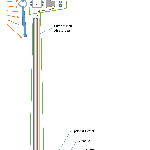Please find below the
Finalist Evaluation
Judges'' ratings
| • | Novelty: | |
| • | Feasibility: | |
| • | Impact: | |
| • | Presentation: |
Judges'' comments
The contributor proposes using the mechanical energy of the windmill's shaft to power an air compressor directly to store energy to power a generator during periods in which the wind is not blowing. The main stakeholder that would be interested in exploring this project would be wind equipment manufacturers, that, if successful, would be able to develop more project, exploiting the energy storage capabilities. A more detailed theoretical analysis should be done in conjunction with the R&D department of a wind turbine manufacturer. They could also sponsor a Master Thesis on the subject if found reliable. If the technology is proven, they would be the most motivated and prepared first adopters for a quick introduction.
Proposal to develop a wind turbine that generates compressed air instead of electricity (thus allowing a constant output from a wind power generator). The efficiency and economics of the proposed device is not well supported in this proposal. I suspect the efficiency of compressed air generation will suffer substantially due to variability in wind resource availability (This is not considered in the current proposal). Nonetheless, this is worthy of initial high level conceptual calculations to see if it is feasible.
Semi-Finalist Evaluation
Judges'' ratings
| • | Novelty: | |
| • | Feasibility: | |
| • | Impact: | |
| • | Presentation: |
Judges'' comments
The main drawback of wind turbines has been the intermittent nature of favorable wind. This can be somewhat offset by building a network of geographically dispersed wind farms. But even this does not eliminate the need for back up power.The proposal involves using the mechanical energy of the windmill's shaft to power an air compressor directly. This reservoir of compressed air can then be used to power a generator during periods in which the wind is not blowing. This approach should certainly be more efficient than siphoning off some of the electricity to power an electric compressor because it reduces losses associated with energy conversion. Of course, electric compressors are readily available and, since they are mass produced, are relatively inexpensive.In my mind, the question is whether the efficiency gains of this tailored device creates sufficient savings to offset the benefits of using a standard off the shelf product.I think some additional information would strengthen the proposal. For example:1. How many wind farms use electrical compressors to store energy? That is, what is the size of the current market?2. What are the energy losses associated with the use of the electrical compressors. That is, losses from converting the wind's mechanical energy to electricity and the losses of converting the electrical energy into mechanical energy for the compressor. These are all published numbers and they will set an upper limit on net potential efficiency gain.3. What is the cost of the electricity produced by the wind farm?4. What would be the maximum possible savings a wind farm could achieve by using directly connected mechanical instead of electrical compressors. In either scenario, some of the wind's energy is being siphoned out to power the compressor. Also, in either scenario the compressed air is being used as a vehicle to store the energy and potentially displace peak generation powered by fossil fuels. So the net saving associated with this proposal will come from the value of efficiency gains. Of course, a real device will not be able to realize 100% the maximum potential savings as calculated using this approach. However, it will provide an upper limit of the value of the concept, which may or may not support the development of a prototype.
No comments have been posted.
